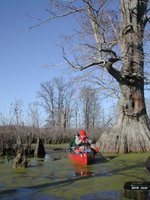Cajunrider
Imperial Masterpiece
I have a still-a-baby bald cypress with a 2" caliper as measured at 1ft level. It has one root that is way too large compared to others around the trunk. I attempted to correct it by tracing the root into the soil about 6" or so then cut off the rest. I hope to restrict the flow through this root and slow its growth way down while stimulating other roots to take up the load and grow bigger. Will this work for bald cypress or any type of tree for that matter?






